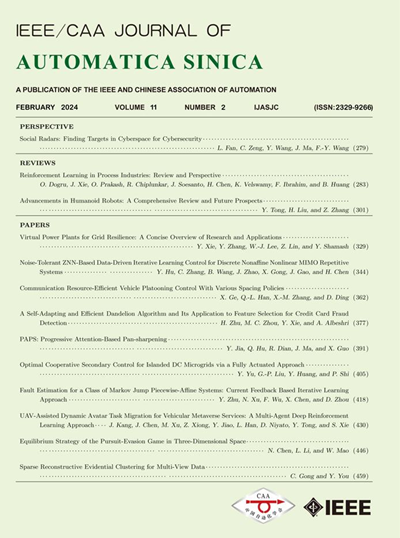基于点积特征分析的火电厂动态过程监控
IF 19.2
1区 计算机科学
Q1 AUTOMATION & CONTROL SYSTEMS
引用次数: 0
摘要
数据驱动的过程监控是保证现代制造和能源系统安全运行的有效途径,如本文所研究的火电厂。工业过程本质上是动态的,需要使用动态算法进行监控。主流的动态算法依赖于将当前测量与过去数据连接起来。这项工作提出了一个新的,替代动态过程监测算法,使用点积特征分析(DPFA)。DPFA计算连续样本的点积,从而自然地通过时间相关性捕获过程动态。同时,DPFA的在线计算复杂度不仅低于现有的动态算法,也低于经典的静态算法(如主成分分析和慢特征分析)。针对过程系统中常见的三种故障:传感器偏置故障、过程故障和增益变化故障,分析了新算法的可检测性。通过数值算例和火电厂实际数据的实验,DPFA算法在监测性能(故障检出率和虚警率)和计算复杂度方面均优于现有方法。本文章由计算机程序翻译,如有差异,请以英文原文为准。
Dynamic Process Monitoring Based on Dot Product Feature Analysis for Thermal Power Plants
Data-driven process monitoring is an effective approach to assure safe operation of modern manufacturing and energy systems, such as thermal power plants being studied in this work. Industrial processes are inherently dynamic and need to be monitored using dynamic algorithms. Mainstream dynamic algorithms rely on concatenating current measurement with past data. This work proposes a new, alternative dynamic process monitoring algorithm, using dot product feature analysis (DPFA). DPFA computes the dot product of consecutive samples, thus naturally capturing the process dynamics through temporal correlation. At the same time, DPFA's online computational complexity is lower than not just existing dynamic algorithms, but also classical static algorithms (e.g., principal component analysis and slow feature analysis). The detectability of the new algorithm is analyzed for three types of faults typically seen in process systems: sensor bias, process fault and gain change fault. Through experiments with a numerical example and real data from a thermal power plant, the DPFA algorithm is shown to be superior to the state-of-the-art methods, in terms of better monitoring performance (fault detection rate and false alarm rate) and lower computational complexity.
求助全文
通过发布文献求助,成功后即可免费获取论文全文。
去求助
来源期刊

Ieee-Caa Journal of Automatica Sinica
Engineering-Control and Systems Engineering
CiteScore
23.50
自引率
11.00%
发文量
880
期刊介绍:
The IEEE/CAA Journal of Automatica Sinica is a reputable journal that publishes high-quality papers in English on original theoretical/experimental research and development in the field of automation. The journal covers a wide range of topics including automatic control, artificial intelligence and intelligent control, systems theory and engineering, pattern recognition and intelligent systems, automation engineering and applications, information processing and information systems, network-based automation, robotics, sensing and measurement, and navigation, guidance, and control.
Additionally, the journal is abstracted/indexed in several prominent databases including SCIE (Science Citation Index Expanded), EI (Engineering Index), Inspec, Scopus, SCImago, DBLP, CNKI (China National Knowledge Infrastructure), CSCD (Chinese Science Citation Database), and IEEE Xplore.
 求助内容:
求助内容: 应助结果提醒方式:
应助结果提醒方式:


